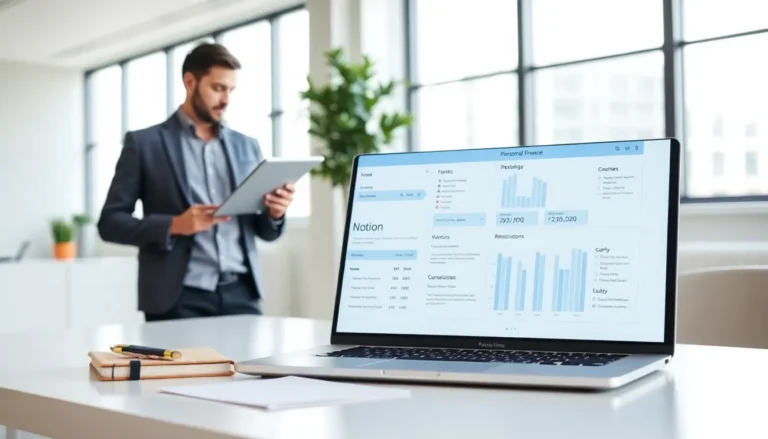Table of Contents
ToggleEver stared at a blank Google Docs page and thought it could use a little pizzazz? You’re not alone. Many users find themselves yearning for that perfect background to transform their mundane documents into visual masterpieces. Whether it’s for a school project or a professional report, adding a background can make all the difference.
Overview of Google Docs Backgrounds
Google Docs offers users the ability to customize document backgrounds, enhancing visual appeal. Customizing backgrounds makes documents stand out, which proves beneficial in academic and professional settings. Users can apply solid colors, images, or patterns to enrich their content.
Adding a background involves a straightforward process. First, users access the “File” menu and select “Page setup.” They will find the option to choose a background color or image here. If selecting an image, Google Docs allows users to upload photos or select from Google Drive.
Various background elements exist that can suit different document types. Simple colors work well for formal documents while images can add personality to more creative works. Using high-quality images ensures clarity and professionalism in the final product.
Moreover, a well-chosen background complements the document’s purpose. For instance, educational materials may benefit from light colors that promote readability. In contrast, marketing presentations may utilize vibrant backgrounds to capture attention.
It’s essential to pay attention to contrast when inserting a background. Text should remain legible against the chosen background, ensuring that the message remains clear. Testing different combinations helps users find the most effective aesthetics.
Finally, Google Docs backgrounds offer a simple way to personalize documents. By infusing creativity, users can produce more engaging and visually appealing outputs. This functionality contributes to the overall effectiveness of the documents produced in Google Docs.
Steps to Insert a Background
Users can easily personalize their Google Docs backgrounds through a few straightforward steps, enhancing the document’s visual presentation. Follow these detailed instructions to achieve the desired effect.
Accessing the Page Setup
Navigate to the “File” menu located at the top left of the screen. Click on “Page setup” from the dropdown options to open a new dialog box. This box provides several settings for adjusting the document. Look for the “Page color” section, where users can modify the background color. After selecting a color, confirm by clicking “OK” to apply the changes.
Adding a Color Background
Choose a solid color to make a document visually striking. Click on the “Page color” option in the “Page setup” dialog box. A color palette emerges, presenting various color options. Select one that suits the document’s theme or style. For formal documents, opt for subtle colors, while vibrant hues may enhance creative projects. After making a selection, click “OK” to set the background color.
Inserting an Image as Background
Adding an image creates a unique and eye-catching background. First, access the “Page setup” from the “File” menu. Unfortunately, Google Docs doesn’t allow direct image uploads as backgrounds. Instead, users can insert a drawing by selecting “Insert” followed by “Drawing” and then “New.” Within the drawing window, click on the “Image” icon to upload a desired picture or select one from Google Drive. Once the image appears, adjust its size to cover the page. Save and close the drawing to finalize the document’s background.
Customizing Background Settings
Customizing background settings enhances a document’s visual appeal. Users can adjust various elements to create unique designs.
Adjusting Transparency
Transparency settings allow users to modify how visible the background appears. Access the drawing in the document, then select the image or shape. Adjust the transparency slider to achieve the desired effect. By decreasing opacity, text readability improves against more complex backgrounds. A transparent image overlay can create a subtle and sophisticated look, ideal for presentations or reports. This technique effectively balances aesthetics with functionality, making it easier to convey important information without overwhelming visuals.
Rearranging Background Layers
Rearranging layers adds depth to the document’s design. Begin by selecting the drawing or image in the document. Right-click or use the options menu to access the “Order” settings. Move images backward or forward to find the perfect position relative to text or other elements. Layering different images or colors creates an engaging visual experience. A well-arranged background enhances the overall presentation, delivering a polished and professional look in Google Docs. Adjusting these elements allows users to customize their documents precisely to their needs.
Common Issues and Troubleshooting
Users often encounter difficulties when inserting backgrounds in Google Docs. A common issue involves low-quality images affecting text readability. High-resolution images should always be prioritized to maintain clarity and avoid distracting visuals.
Another problem arises when users try to adjust transparency. If the background isn’t adequately transparent, it can obscure text, making it hard to read. Ensuring proper transparency levels is essential for balancing aesthetics and function.
Compatibility issues may also prevent images from displaying correctly. Unsupported formats or large file sizes can lead to incomplete uploads or distortion. Users should verify that their images meet Google Docs’ requirements, typically using formats like JPEG or PNG.
Layering backgrounds can present challenges as well. Users sometimes struggle to rearrange layers to achieve the desired visual effect. Utilizing the “Order” feature in the “Drawing” menu helps effectively manage layer positioning, enhancing depth in the document.
Occasionally, users face restrictions in modifying existing templates. Certain templates may have preset backgrounds that restrict further changes. Users can duplicate the document and start fresh, allowing full customization.
Unexpected background changes can occur too. Users may find their background reset after reopening the document. Saving changes frequently and checking settings before exiting helps maintain desired configurations.
Issues with the “Page setup” menu might emerge as well. Users may not find the option due to layout changes or interface updates. Accessing the “File” menu directly provides a reliable path to “Page setup,” ensuring background adjustments are straightforward.
By addressing these common challenges, users can enhance their Google Docs experience and create more visually engaging documents.
Adding a background in Google Docs can significantly enhance the visual impact of a document. By following the outlined steps and considering the document’s purpose users can create engaging and professional presentations.
Choosing the right background elements not only elevates the aesthetic appeal but also ensures that the content remains readable. With a few simple techniques like adjusting transparency and layering images users can achieve a polished look that captures attention.
Overcoming common challenges in background insertion can lead to a more satisfying Google Docs experience. Ultimately a well-designed background can transform a standard document into an effective communication tool.








